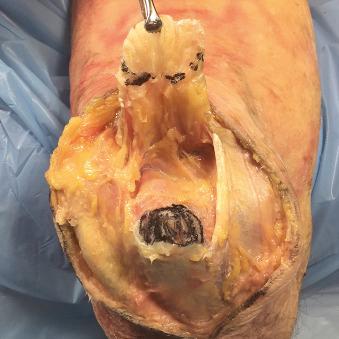Physical Address
304 North Cardinal St.
Dorchester Center, MA 02124
Distal triceps tendon injuries are very rare.
These injuries have a 2:1 male:female ratio and are most commonly seen in individuals 30 to 50 years of age.
These injuries occur after an eccentric loading of the triceps tendon.
Tears involving less than 50% of the tendon may be treated conservatively.
Complete tears require operative fixation.
Several techniques exist for fixation, each providing good to excellent outcomes.
Triceps tendon injuries are rare tendon injuries that can lead to significant dysfunction if not diagnosed and treated in a timely and appropriate fashion. These injuries can be encountered in the context of a high-energy trauma or with a low-energy mechanism in the setting of a predisposing systemic condition. This chapter reviews the common presentation, evaluation, and treatment strategies for triceps tendon injuries, focusing on both nonoperative and operative treatment options.
Distal triceps tendon ruptures are uncommon injuries. noted that fewer than 1% of all tendon injuries involved the triceps. These occur approximately twice as often in males as in females, most commonly affecting patients between 30 and 50 years of age ( ). In the general population, several systemic conditions may predispose a patient to triceps tendon rupture, including diabetes mellitus, hyperparathyroidism, and chronic renal disease ( ). Local irritation from chronic olecranon bursitis may also increase the risk of rupture ( ). Athletes who sustain triceps tendon rupture tend to engage in activities that require elbow extension against high loads, such as those seen in power lifting and American football ( ). In 1996, reported on 21 triceps tendon ruptures occurring over the previous six seasons in professional football players. Using the National Football League (NFL) Injury Surveillance System, our institution identified 37 additional cases of triceps tendon rupture occurring between 2000 and 2009 ( ). Last, both the use of systemic anabolic steroids and repeated local corticosteroid injections have also been linked to an increased occurrence of triceps tendon rupture, particularly in weight lifters ( ).
The triceps brachii muscle is the sole muscle occupying the posterior compartment of the upper arm and is innervated by the radial nerve (C6–C8). It is composed of three tendinous origins: the long, lateral, and medial heads. The long head originates at the infraglenoid tuberosity of the scapula. The lateral head originates on the lateral intramuscular septum and posterolateral humerus proximal to the radial groove on the posterior aspect of the humerus. The medial head arises distal to the spiral groove on the posterior humerus. The confluence of the triceps heads inserts as a broad footprint along the olecranon ( Fig. 31.1 ). The proximal aspect of the footprint begins approximately 12 mm distal to the tip of the olecranon and covers an area of 466 mm 2 ( ). The medial aspect of the triceps insertion extends along the posterior crest of the ulna. Laterally, the insertion expands to blend with the fascia of the extensor carpi ulnaris and anconeus muscle. The overall width of the insertion has been found to be between 1.9 and 4.2 cm ( ).

The diagnosis of a distal triceps tendon injury can generally be made clinically. Most commonly, the patient will report a history involving an eccentric loading mechanism to the arm. This is commonly experienced during a fall onto an outstretched hand, weight lifting, or attempting to restrain oneself during a motor vehicle accident. Deep lacerations to the posterior distal aspect of the arm are also capable of completely transecting the triceps tendon. Rarely, a direct blow to the posterior arm can be responsible for a tear ( ).
Patients complain of pain localized over the posterior aspect of the elbow. On physical examination, they may exhibit swelling, tenderness, and ecchymosis. Patients with a complete rupture may have a palpable gap proximal to the tip of the olecranon; however, this is commonly masked by swelling during the acute injury period. Active extension of the elbow should be assessed in all patients with a suspected triceps tendon rupture. It is important to recognize that retention of the ability to actively extend the elbow against resistance does not rule out a triceps tendon rupture ( ). A complete tear may result in a total loss of active elbow extension. A patient with an intact lateral insertional expansion or with compensatory strength from the anconeus muscle may retain the ability to extend the triceps against gravity with the arm positioned below the shoulder. These patients should also be tested with the arm overhead and against resistance to help confirm the diagnosis ( ).
Special tests include a modified Thompson test that is akin to the Thompson test used for Achilles tendon rupture ( ). During this examination, the patient is placed in a prone position with the affected arm over the edge of the table and the elbow flexed to 90 degrees. The examiner then squeezes the triceps and watches the elbow for passive extension. If there is a compete rupture of the triceps tendon, then there will likely be no motion at the elbow.
Become a Clinical Tree membership for Full access and enjoy Unlimited articles
If you are a member. Log in here